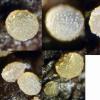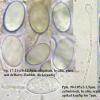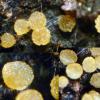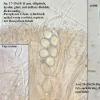
21-12-2025 09:32
Hello.A tiny ascomycete found embedded in wood in

21-12-2025 21:32
Pol DebaenstHello, Garden, Burgweg 19, Veurne, BelgiumOn 10/1

22-12-2025 23:38
Patrice TANCHAUDBonsoir, récolte sur un mur en pierre, apothéci

22-12-2025 00:47
Patrice TANCHAUDBonsoir, récolte à proximité du milieu dunaire

21-12-2025 21:40
Isabelle CharissouBonjour, j'aimerais connaitre les références de

20-12-2025 23:08
Patrice TANCHAUDBonsoir, récolte sur sol sablonneux dans l'arri�
Coprotus...ochraceus?
Björn Wergen,
04-04-2011 02:11
 Hi again,
Hi again,the findings of the last days will be microscoped again, but first I have some problems with Coprotus. 2005 I had found some of Coprotus but was not really able to determine them. Now, with more literature and more experience, I hoped to be ready for Coprotus, but it seems as if I am wrong with it.
Fruitbody 0,5-1 mm, disc-shaped, whitish to yellow-whitish, with protuding asci. Spores 17-21x10-12,5 µm, ellipsoid, hyaline, really smooth, with deBarry-Bubble (I hope it is right), thickwalled. Asci 90-100x20-30 µm, cylindrical, with 8 spores in different arrangement, Spores in Asci with gel-sheath (similar to immature Ascobolus immersus spores...). Paraphyses cylindrical, 90-100x2-3 µm, apices up to 7 µm, hyalin, septate, rarely branched.
On dung of wild pig.
Perhaps someone has an idea. My problem is the spore size, C. ochraceus and C. leucopocillum with both 8spored asci have smaller spores...
regards,
Kazuya
Michel Delpont,
04-04-2011 11:56

Re:Coprotus...ochraceus?
hello.
Coprotus species of the genus are often difficult to separate. The size of the spores seem a little large for leucopocillum. Ochraceus is normally more pigmented than leucopocillum, bigger in size, and has also more pigmented paraphyses. The exipulum is also normally low cyanophilous.
Regards.
Coprotus species of the genus are often difficult to separate. The size of the spores seem a little large for leucopocillum. Ochraceus is normally more pigmented than leucopocillum, bigger in size, and has also more pigmented paraphyses. The exipulum is also normally low cyanophilous.
Regards.
Björn Wergen,
04-04-2011 21:09

Re:Coprotus...ochraceus?
Hi Michel,
thank you for the answer. I checked another substrate, also wild pig, and found more orange-yellow to pale ochraceous-yellow apothecia in the same size as the finding before, but different microscopical features like the smaller spores (17-19x10-11µm) and not inflated paraphyses with pale yellow pigment. I will show the photos right here ;)
I think this should be C. ochraceus.
regards,
Kazuya
--------------
edit: Asci open by an operculum!
thank you for the answer. I checked another substrate, also wild pig, and found more orange-yellow to pale ochraceous-yellow apothecia in the same size as the finding before, but different microscopical features like the smaller spores (17-19x10-11µm) and not inflated paraphyses with pale yellow pigment. I will show the photos right here ;)
I think this should be C. ochraceus.
regards,
Kazuya
--------------
edit: Asci open by an operculum!
Michel Delpont,
09-04-2011 14:28

Re:Coprotus...ochraceus?
OK, this seems to fit; excuse my delay but I had a computer problem.
Regards.
Regards.
Björn Wergen,
10-04-2011 17:08

Re:Coprotus...ochraceus?
Hi Michel,
many thanks for your opinion, it does not matter if it was a bit late ;)
regards,
Kazuya
many thanks for your opinion, it does not matter if it was a bit late ;)
regards,
Kazuya



